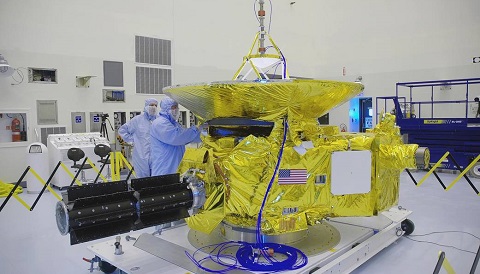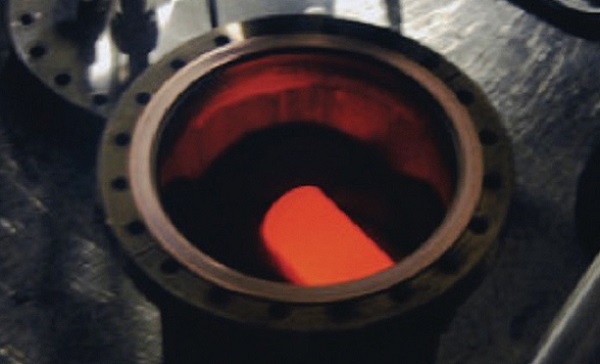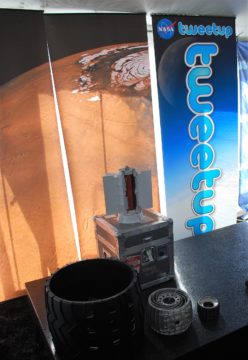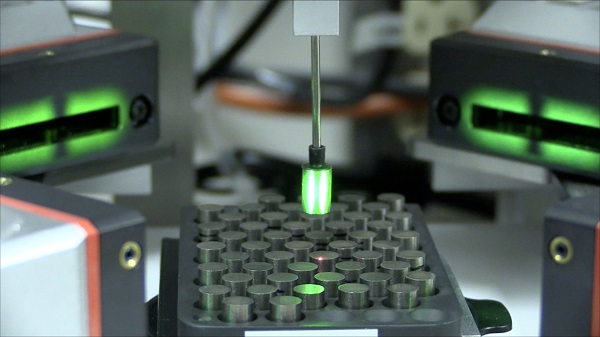Automation of a key process may yield an eightfold boost to U.S. plutonium production, a promising development for deep-space exploration.

NASA / Department of Energy.
A new innovation may solve a major dilemma in deep space exploration. Oak Ridge National Laboratory, based in Tennessee, recently announced a way to speed up production of the plutonium isotope plutonium-238 (Pu-238), a crucial element for deep space exploration. The solution comes as NASA looks to return to the outer solar system in the 2020s and field a new generation of deep-space missions.
Why Plutonium?
Solar panels work great for powering spacecraft in the inner solar system, but solar energy drops off by the inverse square of the distance as probes travel farther from the Sun. NASA's Juno mission, for example, is the first spacecraft to visit Jupiter that is equipped with solar panels — but it needs three school bus-size panels to generate a minuscule 420 watts of electricity. That's only enough to power a half a dozen household light bulbs. Solar panels are also delicate: one encounter with the donut of plasma that circles Jupiter, which is fueled by particles expelled from volcanic moon Io, would end Juno's mission in a hurry.
Using solar panels is also problematic in places where sunlight isn't constant. The 2018 global dust storm on Mars, for example, may have dealt a death blow to solar-powered Opportunity, though nuclear-powered Curiosity weathered the storm without a hitch.

NASA / U.S. Department of Energy
Radioactive plutonium is an ideal power source for remote exploration, far from the Sun. Compact and lightweight, the radioactive element has a half-life of 87.7 years, meaning it's still generating half its original output — equivalent to 570 watts per kilogram — nearly nine decades after production. Plutonium fueled Voyagers 1 and 2, which were launched in 1977 and are still going strong, 144.5 astronomical units (a.u.) and 119.7 a.u. from the Sun, respectively. In fact, any would-be alien salvagers could potentially date the probes' production by examining the trace amounts of radioactivity from their Pu-238 power source.
The Lingering Plutonium Shortage

Pu-238 has its drawbacks, though. The element does not occur in nature; it was produced in the United States as a byproduct of fissile Pu-239, manufactured for nuclear weapons during the Cold War. Plutonium production ceased in 1988, and NASA has been drawing from a dwindling stockpile ever since to fuel missions such as Cassini and New Horizons. The exact amount of Pu-238 in NASA's inventory is classified, but it's thought to be enough to fuel the Mars 2020 rover plus two more missions like it. In fact, Curiosity actually utilized plutonium purchased from the Russian stockpile. Another concern is that even the plutonium that remains is decaying away — since its production in 1988, the total quantity would have decayed by 22% in 2019.
NASA missions use plutonium to generate electricity via a Multi-Mission Radioisotope Thermoelectric Generator (MMRTG). Launching RTG-equipped spacecraft isn't without risks: a Transit 5BN-3 spacecraft, along with its RTG, reentered over the Indian Ocean shortly after launch on April 21, 1964, and the returning Apollo 13 astronauts ditched an RTG meant for the ALSEP lunar surface experiments over the Marianas Trench in the Pacific in 1970. However, neither incident showed any sign of radioactive leakage. When planning the New Horizons launch in 2006, NASA calculated a very low chance of launch failure with radioactive contamination: 300-to-1.
Solutions to the Shortage
In 2013 the Department of Energy restarted plutonium production for deep space exploration. The targeted goal is a sustained production of 1.5 kilograms per year by 2025. That would be enough to meet the needs for the next generation of proposed outer solar system missions, including Europa Clipper, a Mars sample return, a Uranus and/or Neptune orbiter, and a Titan helicopter mission, all of which will need to be nuclear-powered.
NASA also researched the possibility of doing more with less with Advanced Stirling Radioisotope Generators (ASRG), which promise to be four times as efficient as traditional MMRTGs. NASA made the tough decision to cancel the ASRG flight development contract during the lean fiscal years around 2013, though the agency continued funding the development of similar technologies through private companies.
Now, scientists at Oak Ridge National Laboratory (ORNL) have another solution in hand — a significant boost in plutonium production speed by way of automation. The first step of the process at ORNL is to press neptunium oxide-aluminum pellets into enclosed aluminum tubes; these are then irradiated at the facility's Flux Isotope Reactor and chemically processed at the Radiochemical Engineering Center. When pressing the pellets into the tubes was done by hand, it presented a time-consuming bottleneck in the pipeline. By automating the process, ORNL hopes to push plutonium production from 50 to 400 grams annually, with the goal of reaching 1.5 kilograms annually by 2025. Currently, plutonium production costs roughly $8 million dollars per kilogram.
“The automation replaces a function our team did by hand and is expected to increase the output of pressed pellets from 80 to 275 per week,” says Bob Wham (ORNL) in a recent press release.

ORNL
The automation also frees up workers for other tasks. Even with safety equipment and protocols, the hours humans can work on production are limited due radiation exposure. “The process was not really difficult, but it was slow and our operators accumulated dose due to handling the powder,” says Wham. “Automation provides a higher throughput on a pellets per hour basis. We can also have multiple activities going on at the same time.”
Although the current partial government shutdown has shuttered NASA for now, this will not affect plutonium production. “The Department of Energy's FY 2019 appropriations bill was approved by Congress and signed by the president in September,” says Jason Ellis (ORNL). “ORNL is operating on a normal schedule.”
The end of NASA's plutonium shortage may soon be in sight, in time for the next generation of spacecraft to mark the return of exploration in the outer solar system.
 3
3









Comments
Fylb
February 1, 2019 at 5:03 pm
I'm sure you are aware that it is a Stirling Engine. Not a Sterling Engine.....
You must be logged in to post a comment.
Monica Young
February 4, 2019 at 8:23 am
Thanks, Fylb, I'll correct this typo.
You must be logged in to post a comment.
Warren-Odom
February 3, 2019 at 12:06 pm
Nice, informative article -- although, 420 watts for half a dozen light bulbs? Not any more -- not in our house anyway, and I hope not in yours, or anyone else's either. More like 40 to 50 of the current technology LED bulbs.
You must be logged in to post a comment.
You must be logged in to post a comment.